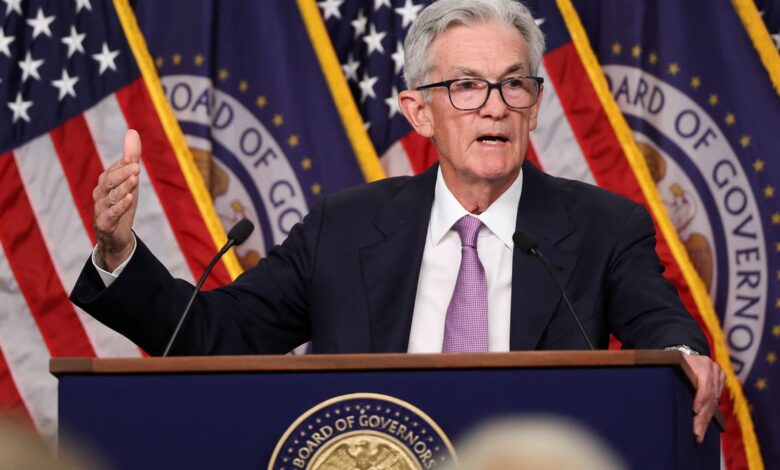The Fed is finally cutting rates, but banks aren’t in the clear just yet

Federal Reserve Board Chairman Jerome Powell holds a press conference following a two-day meeting of the Federal Open Market Committee on interest rate policy in Washington, U.S., September 18, 2024. REUTERS/Tom Brenner
Tom Brenner | Reuters
Falling interest rates are usually good news for banks, especially when the cuts aren’t a harbinger of recession.
That’s because lower rates will slow the migration of money that’s happened over the past two years as customers shifted cash out of checking accounts and into higher-yielding options like CDs and money market funds.
When the Federal Reserve cut its benchmark rate by half a percentage point last month, it signaled a turning point in its stewardship of the economy and telegraphed its intention to reduce rates by another 2 full percentage points, according to the Fed’s projections, boosting prospects for banks.
But the ride probably won’t be a smooth one: Persistent concerns over inflation could mean the Fed doesn’t cut rates as much as expected and Wall Street’s projections for improvements in net interest income — the difference in what a bank earns by lending money or investing in securities and what it pays depositors — may need to be dialed back.
“The market is bouncing around based on the fact that inflation seems to be reaccelerating, and you wonder if we will see the Fed pause,” said Chris Marinac, research director at Janney Montgomery Scott, in an interview. “That’s my struggle.”
So when JPMorgan Chase kicks off bank earnings on Friday, analysts will be seeking any guidance that managers can give on net interest income in the fourth quarter and beyond. The bank is expected to report $4.01 per share in earnings, a 7.4% drop from the year-earlier period.
Known unknowns
While all banks are expected to ultimately benefit from the Fed’s easing cycle, the timing and magnitude of that shift is unknown, based on both the rate environment and the interplay between how sensitive a bank’s assets and liabilities are to falling rates.
Ideally, banks will enjoy a period where funding costs fall faster than the yields on income-generating assets, boosting their net interest margins.
But for some banks, their assets will actually reprice down faster than their deposits in the early innings of the easing cycle, which means their margins will take a hit in the coming quarters, analysts say.
For large banks, NII will fall by 4% on average in the third quarter because of tepid loan growth and a lag in deposit repricing, Goldman Sachs banking analysts led by Richard Ramsden said in an Oct. 1 note. Deposit costs for large banks will still rise into the fourth quarter, the note said.
Last month, JPMorgan alarmed investors when its president said that expectations for NII next year were too high, without giving further details. It’s a warning that other banks may be forced to give, according to analysts.
“Clearly, as rates go lower, you have less pressure on repricing of deposits,” JPMorgan President Daniel Pinto told investors. “But as you know, we are quite asset sensitive.”
There are offsets, however. Lower rates are expected to help the Wall Street operations of big banks because they tend to see greater deal volumes when rates are falling. Morgan Stanley analysts recommend owning Goldman Sachs, Bank of America and Citigroup for that reason, according to a Sept. 30 research note.
Regional optimism
Regional banks, which bore the brunt of the pressure from higher funding costs when rates were climbing, are seen as bigger beneficiaries of falling rates, at least initially.
That’s why Morgan Stanley analysts upgraded their ratings on US Bank and Zions last month, while cutting their recommendation on JPMorgan to neutral from overweight.
Bank of America and Wells Fargo have been dialing back expectations for NII throughout this year, according to Portales Partners analyst Charles Peabody. That, in conjunction with the risk of higher-than-expected loan losses next year, could make for a disappointing 2025, he said.
“I’ve been questioning the pace of the ramp up in NII that people have built into their models,” Peabody said. “These are dynamics that are difficult to predict, even if you are the management team.”




